
by Alessia Leibert
March 2022
Gender wage gaps are evident for students who participate in Career and Technical Education (CTE) because female-dominated professions provide fewer opportunities for career preparation during high school than male-dominated professions. CTE can contribute toward addressing this equity issue.
This article is the second in a series focused on analyzing the outcomes of Minnesota students who take CTE courses while in high school. The main objective of this research is to better understand the degree to which CTE was successful at facilitating both workforce entry and college completion for students. Other research objectives are to identify which program features drive the most desirable outcomes so that school administrators, policy makers, and employers can invest more in what worked best. Although we had originally intended to analyze CTE students as a unified group, ultimately we chose to separate the analysis by gender because we noticed underlying patterns in the data that we thought would be of interest to educators, employers seeking to attract applicants, and families wanting to help their students navigate career and college readiness choices.
Specifically, this article considers the following research questions:
The article starts with documenting the gender divide in CTE course participation patterns among 442,071 Minnesota students who attended high school from 2007 to 2017. It then delves into the post-high school educational and labor market outcomes of female students from the 2010-2014 cohorts, which represents the most current data available at the time this article was published. Finally, the article will discuss the potential implications of these findings for gender pay gaps.
From 2007 to 2017, 80% of Minnesota high school graduates took at least one CTE course. However, there is large variation in intensity of CTE participation across students. We distinguish between four levels of participation:
Table 1 summarizes the characteristics of the four groups in terms of size and hours of CTE instruction taken overall, highlighting a strong gender divide in CTE.
| Gender | Category of CTE participation, by gender | Share of total students | Avg number of hours of CTE instruction |
|---|---|---|---|
| Females | GROUP 1: Concentrators | 34% | 407 |
| GROUP 2: Explorers | 15% | 228 | |
| GROUP 3: Samplers | 29% | 91 | |
| GROUP 4: Non-participants | 23% | 0 | |
| Total N, cohorts 2009-2018 | 221,065 | 256 | |
| Males | GROUP 1: Concentrators | 48% | 480 |
| GROUP 2: Explorers | 15% | 238 | |
| GROUP 3: Samplers | 22% | 94 | |
| GROUP 4: Non-participants | 16% | 0 | |
| Total N, cohorts 2009-2017 | 221,006 | 338 | |
| Source: Author's calculations based on data from the Statewide Longitudinal Education Data System (SLEDS) | |||
First, males took more hours of CTE instruction on average, 338 versus 256 among females. Second, males were much more likely to be concentrators (48% versus 34% among females).
Previous research on male students did not find relevant differences in medium-term labor market outcomes between explorers, samplers and non-participants, and a preliminary analysis revealed the same to be true among females. Therefore, this study will compare concentrators to everyone else.
The characteristics most commonly associated with CTE concentration status among females are: attending high school in Greater Minnesota; having low family income; receiving special education services; and not being proficient in reading and math in standardized tests taken in 8th grade (Figure 1).
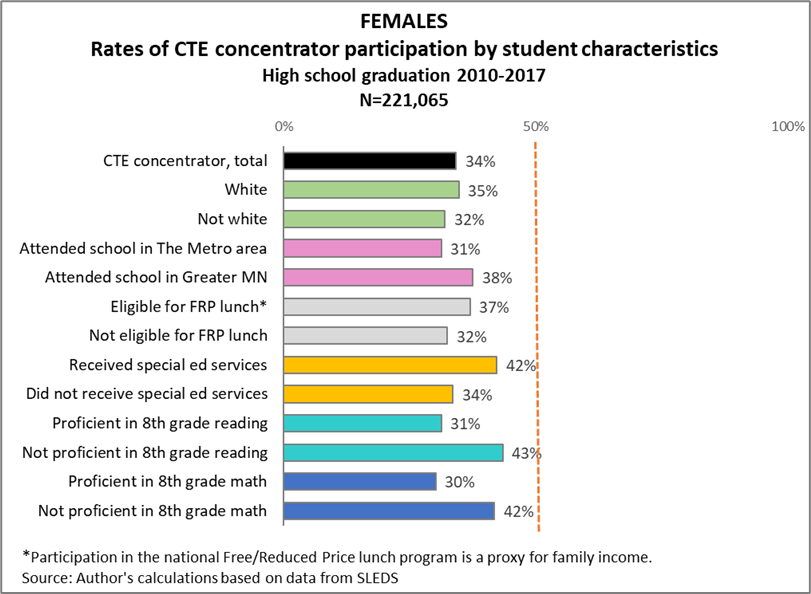
The remainder of the article will focus only on females who did not receive special education services in the last two years of high school1.
Given the socio-economic and academic profile of female CTE concentrators documented in Figure 1, we expect to see gaps in postsecondary educational outcomes between concentrators and non-concentrators. Table 2 documents these gaps.
| Educational outcomes 7 years post high school graduation | Non-concentrators | Concentrators | ||
|---|---|---|---|---|
| Students in each category | Share of total students | Students in each category |
Share of total students |
|
| Did not enroll in college | 6,315 | 7.4% | 4,042 | 9.7% |
| Enrolled but did not complete | 17,249 | 20% | 10,705 | 26% |
| Credential below bachelor's | 11,235 | 13% | 7,938 | 19% |
| Bachelor's or above | 46,454 | 54% | 16,951 | 41% |
| Still enrolled after 7 years, have not completed a credential | 4,372 | 5% | 2,139 | 5% |
| Total | 85,625 | 100% | 41,775 | 100% |
| Enrollments and completion figures include out-of-state students as reported by the National Students Clearinghouse.
Source: Author's calculations based on data from SLEDS |
||||
Non-concentrators had higher educational attainment than concentrators both in terms of overall credential attainment rates (67% versus 60%) and in terms of completing a bachelor's degree or higher credential (54% versus 41%). The 26% of concentrators who enrolled but did not finish a credential raises particular concern; though it should also be pointed out that the overall number of non-concentrators enrolling but not completing a degree is still higher than one would hope (n=17,249).
Our analysis of work outcomes is based on median wages and their growth over time, representing students' earnings potential1. The first analysis documented four main mechanisms of participation in CTE that influence greater earnings and earnings growth among male students. As a reminder, male CTE students benefit from:
Concentrating in a cohesive sequence of state-approved CTE courses, the effect of the first mechanism on female students' earnings, is displayed in Figure 2. Since female concentrators are more likely than non-concentrators to have lower academic proficiency in 8th grade, comparing the economic outcomes of students regardless of academic proficiency (see Total column, Figure 3) makes it appear as if the two groups have identical earnings ($32,352 versus $32,051). However, when results are broken down into categories of proficiency - comparing students who are not proficient in either Reading and Mathematics by 8th grade versus students who tested proficient or higher in both Reading and Math - we discover that female concentrators actually earn more than non-concentrators. In particular, the 17,014 non-academically proficient concentrators ($29,369) had higher earnings in Year 7 as compared with non-proficient non-concentrators ($28,552). Since non-proficiency is correlated with other disadvantages such as low income and needing English language services3, this result is encouraging and suggests that perhaps concentrating in CTE may have boosted earnings potential for non-academically proficient females.
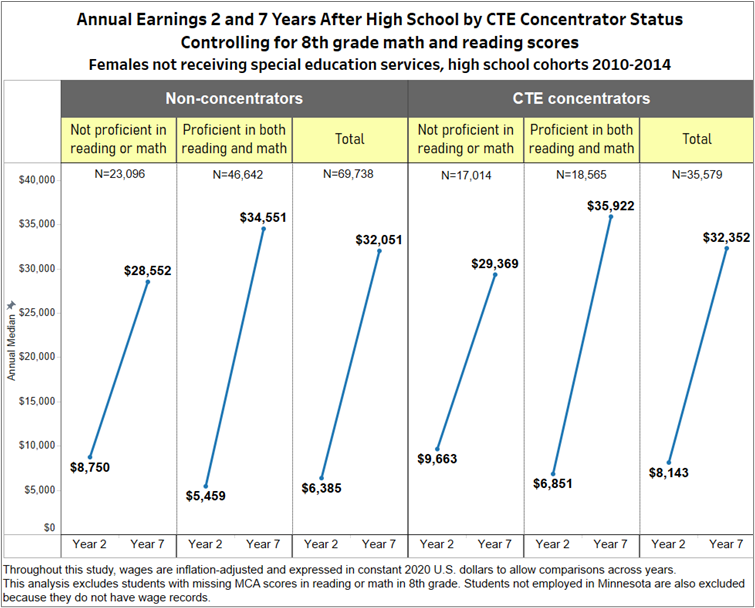
For these students, CTE might represent the best opportunity in high school for exploring careers and preparing for workforce entry. Given the chronic shortage of high school counselors in Minnesota, participation in CTE as concentrators might be an important conduit through which disadvantaged students access career information and education planning resources.
In terms of wage growth, academically proficient students, who focused more on earning a postsecondary credential versus going straight into a career, started from lower earnings in Year 2 then experienced a steep earning curve upward, regardless of concentrator status.
Based on these results, we conclude that the labor market benefits of participating in CTE accrue to those students who become concentrators, but not to other types of CTE participants. This result stems from the fact that concentrators are more likely to intentionally engage in a cohesive sequence of courses (i.e. career pathway) aimed at developing occupational skills in greater depth as compared with other CTE participants who are more inclined to explore a variety of career fields. For example, rather than taking only an entry level course such as "Fundamentals of Food Preparation", CTE concentrators might also continue on to take "Culinary 1 and 2", which is a much more advanced course. After completing a year or more in one career area, CTE Concentrators also have the potential to earn an industry recognized credential prior to graduating high school. For example, in keeping with the culinary example, students could earn a culinary credential such as SafeServ or engage in a ProStart4 competition both of which demonstrate a high level of learning and skill.
Do the benefits of concentrating accrue mainly to females who earn postsecondary credentials? If that were the case, then concentrators would still need to invest in some kind of postsecondary schooling. To answer the question, Figure 3 breaks down the totals from Figure 2 into four postsecondary educational attainment categories: No college, some college, no credential, credential below bachelor's, and bachelor's or above, both for non-concentrators and CTE concentrators.
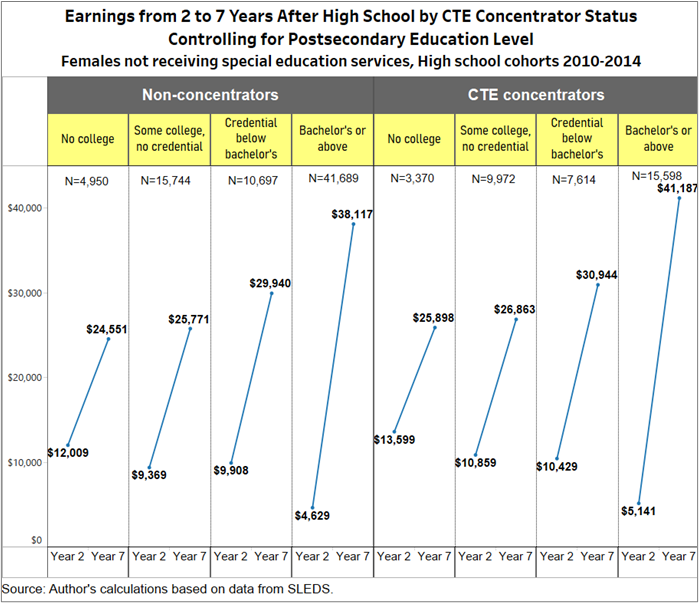
Based on the information in Figure 4, we can see there is a much larger share of non-concentrators (41,689, or 57% of the group) who completed a bachelor's degree or above. This is not surprising, considering the better academic preparedness of these students in middle school. However, once we take education level into account we see that concentrators end up with slightly higher earnings in Year 7 across all subgroups. These wage differences, albeit small, continue to hold even when controlling for 8th grade reading and math proficiency, economic status, race, region of employment, and other characteristics known to influence earnings5.
From this we conclude that concentrating in CTE is not a hindrance to enrolling and completing a postsecondary credential. And further, that concentrating has positive effects on career earnings especially among females who complete a postsecondary credential. This is good news for female students aiming to become CTE concentrators regardless of their post-high school career or college goals. Even so, when comparing these results with Figure 5 in the first report we notice that the "no college" and "some college" subgroups of females did not get as much of a boost from participating in CTE as their male peers. Overall, more males were able to rely on the skills they learned through high school CTE as concentrators as a path towards gainful employment without postsecondary schooling. This finding is disappointing news for gender equity in career earnings because it implies that female students need to incur additional investments in higher education in order to match the earnings growth of their male peers. One possible reason for this observed difference could be due to gender differences in occupational specializations, which we will examine more closely in the next section.
The third important mechanism driving work outcomes is the specific field of study in which students completed the highest number of CTE course hours. Figure 4 demonstrates the power of this mechanism by displaying annual median wages in the eleven largest CTE fields of study. The chart also displays the gender breakdown within each field, revealing a troubling pattern: with the exception of Healthcare (which led to disproportionately high wages among females) and Audiovisual technician and web graphics (which led to disproportionately low wages among males), the lower the earnings the greater the share of female students existing in that field. The most highly female-dominated CTE fields of study, for example Culinary arts/cosmetology and tourism, led to some of the lowest wages seven years after graduation, $30,299 among females and $32,275 among males.
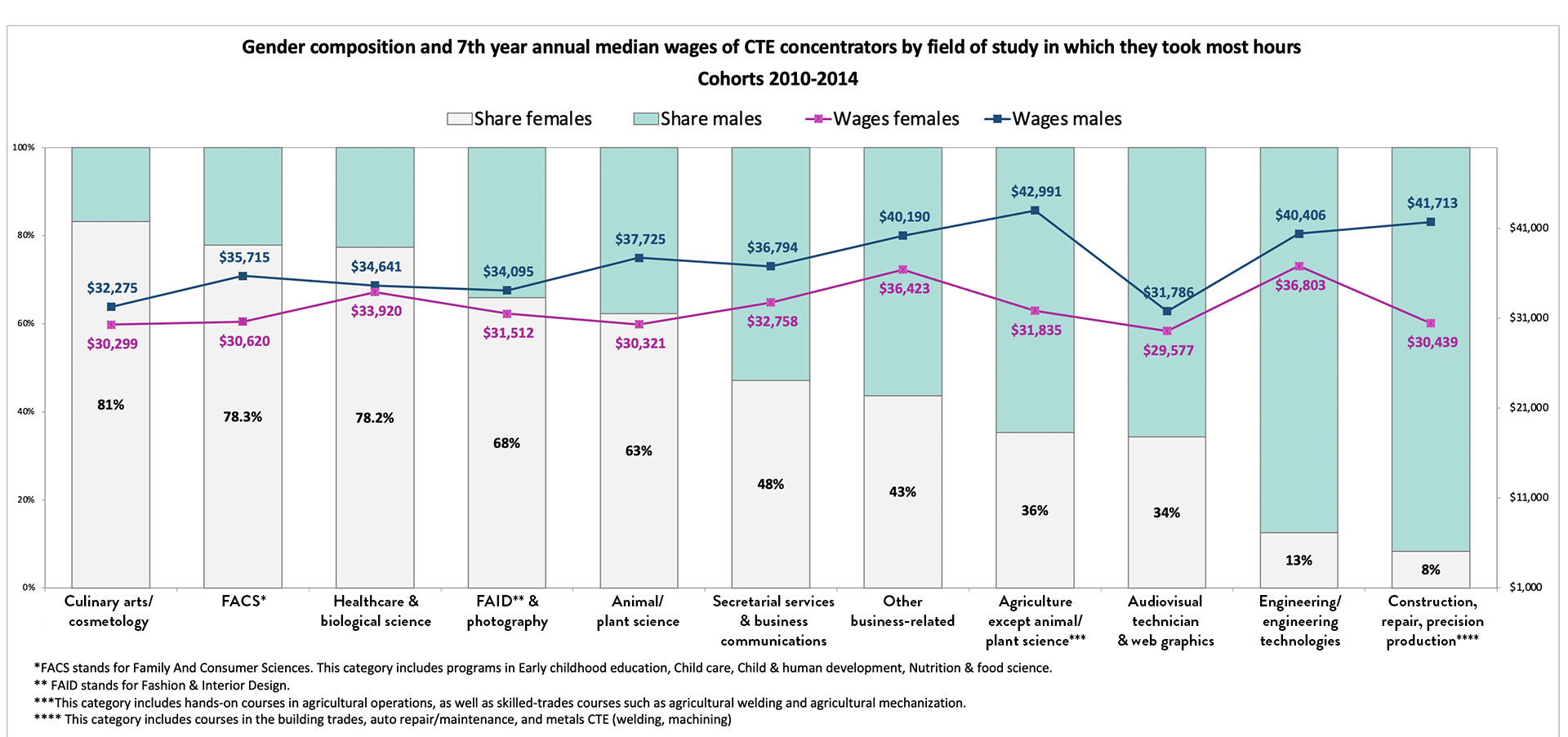
The two most female-dominated fields of study focus on life skills, such as parenting, cooking, and nutrition, or on careers in childcare and early childhood education. Additional information and follow-up investigations would be needed in order to discern whether female students choose these course topics intending to pursue occupations in these fields or whether they completed this course of study out of personal interest alone. While completing courses in these areas of study undoubtedly prepare students for life as an adult, it is also clear that these courses represent some of the most popular CTE courses among females and that these careers result in lower wages for females.
Gender pay gaps are particularly evident in the two extremely male-dominated fields: Agriculture except animal/plant science and Construction/repair/precision production. Why are wages so much lower among females concentrating in these fields? There appear to be two key reasons. First, male concentrators take a greater number of advanced courses within a sequence as compared with female students in the same field of study. This most likely assists male students in acquiring additional knowledge and skills in a given area. Second, females are more likely to take less technical and hands-on courses than males even within the same field of study. For example, rather than enrolling in courses leading to in-demand skills certifications, such as machining or welding, females in the skilled trades are more likely to take "Wood construction & finishing." This precludes them from earning a wide range of industry-recognized credentials while still in high school.
To give a sense of why course content matters and the impact course content has on later outcomes, Table 3 reports examples of official CTE course descriptions comparing female-dominated with male-dominated courses.
| Male-dominated introductory courses in Construction/repair/precision production and Agriculture | Female-dominated introductory courses in Culinary arts, FACS, Healthcare and Visual arts |
|---|---|
|
Welding courses (taken by 11,135 male concentrators*) enable students to gain knowledge of the physical and chemical properties, uses, and applications of various metals. Students gain skills in various processes used to join and cut metals, such as oxyacetylene welding and cutting, plasma cutting, shielded metal arc welding (SMAW or stick), gas metal arc welding (GMAW or MIG), and tungsten inert gas welding (TIG). They gain experience in identifying, selecting, and using appropriate techniques. Other various tools and machines needed in the welding shop will be learned, demonstrated and used as well. Such skills could be mastered by allowing them to practice their welding skills on small projects. Students may begin to read and interpret blueprints in order to identify, select, and use appropriate techniques. These courses may prepare students to pass relevant industry certifications. Auto Service courses (taken by 3,310 male concentrators) emphasize preventative auto maintenance and automobile troubleshooting. Course content typically includes tune-up, oil change, and lubrication skills; tire replacement, alignment, and balancing; and basic knowledge of brake, cooling, electrical, emission, fuel, ignition, steering, suspension, and transmission systems. In addition, this course will introduce the student to reading technical publications and sharing communication with industry experts at a detail-oriented and technical level. This is meant to be an introduction course to start a student on the pathway to becoming a "B" level technician. Certification in areas of ASE, manufacturers, and shop safety may result from taking these courses. General construction courses (taken by 6,273 male concentrators) provide students with basic knowledge and skills required for construction of commercial, residential, and institutional structures. These courses provide experiences and information (typically including career opportunities and training requirements) regarding construction-related occupations such as carpentry, cabinetmaking, bricklaying, electrical trades, plumbing, concrete masonry, and so on. Students engage in activities such as reading blueprints, preparing building sites, starting foundations, erecting structures, installing utilities, finishing surfaces, and providing maintenance. Agricultural Power Systems Technology courses (taken by 3,364 male concentrators) provide students with the skills and knowledge that are specifically applicable to the tools and equipment used in the industry. While learning to apply their knowledge of the basic principles of technological design and production skills (engine mechanics, power systems, welding, and carpentry, among others), students may explore the operation, mechanics, and care of tools and machines; the construction and repair of structures integral to agricultural operations; a study of electricity and power principles; and the study of alternative fuels, technology and engineering, and safety procedures. |
Global foods courses (taken by 6,033 female concentrators) address the following topics: Farm to Table Processes, Hunger Issues, Dining Etiquette from around the world, Culture and Foods, Rituals, Religion, and Traditions, World Foods, Regional Foods. Students will be exposed to how food is grown and processed in order to reach the dinner table, as well as cultural influences on the development and preparation of food. Students will learn advanced skills and concepts on selecting, storing, and preparing and serving foods while preserving their nutrients, flavors, textures and colors Foods and nutrition courses (taken by 7,829 female concentrators) provide students with knowledge and skills related to commercial food preparation and/or production, with a strong emphasis on nutrition, balanced diets, and satisfying special dietary needs. Topics typically include assessing nutrient content, the science of food and nutrition, physiology and utilization of nutrients. Course content may also cover additives, contaminants, food- borne illnesses, and food technology. Parenting and child development courses (taken by 4,068 female concentrators) provide students with knowledge about family systems and relationships and information about how parents can address the physical, mental, emotional, and social growth and development of children from conception to adolescence. In addition, these courses help students discover how parents should respond to the various stages of childhood. Course content typically includes topics such as prenatal development and birth processes, responsibilities and difficulties of parenthood, family structures, societal and cultural influences, fundamentals of children's emotional and physical development, and the appropriate care of infants, toddlers, and young and school-aged children. Nursing assistant courses (taken by 514 female concentrators) The students perform skills in a supervised laboratory setting as well as a long-term care clinical setting. Course uses approved curriculum and meets the requirements of Minnesota Department of Health to prepare students to take the state of Minnesota Nursing Assistant Competency Examination. Housing and interior design courses (taken by 5,257 female concentrators) focus on technical aspects of the design process, including building codes, legal building restrictions, building lot requirements, sustainable materials and construction. These courses help students analyze and use a variety of materials, techniques, and processes in their interior design work. Courses may also include a study of the history of interior design, aesthetic issues, roles and functions, and instruction in the critique process. |
| *These numbers represent CTE concentrators who attended a Minnesota public high school from 2007 to 2015. Counts for welding would have been much higher if we had included intermediate and advanced welding courses.
Source: List of all Career and Technical Education Programs and Courses (Table C) and Minnesota Common Course Classification (MCCC) Catalogue K-12 (2020) |
|
The most female-dominated courses are less industry-focused, less hands-on, less technically rigorous, and geared more towards the development of soft skills or careers in very low wage industries. Among the few exceptions are healthcare-related courses, such as Nursing assistant courses, which prepare for exams that can lead to certification. From 2007 to 2015, however, only 514 female concentrators took Nursing Assistant courses. Even with this credential, an entry level nursing assistant position is a very low wage occupation in comparison with male dominated trades and production occupations.
To summarize this analysis, the third mechanism driving CTE workforce outcomes– choice of CTE subject area – tends to work against females who are less likely to choose high-demand or well-compensated CTE subject areas, which hurts their earnings prospects. The fact that the gender composition of CTE subject areas of concentration did not change substantially since 20106 shows how difficult it is to break the mold of societal norms that underlie these choices.
The next step in our analysis is to investigate whether the results we obtained when answering Research Question 3 continue to hold when we account for differences in field of study. The questions we would like to answer are:
Table 4 answers these questions by displaying the six most popular CTE fields of concentration among females broken down by educational attainment. Educational outcomes represent all concentrators, while wage outcomes represent only those employed in Minnesota seven years after high school.
| Field of study of concentration | Educational outcomes within 7 years from high school graduation |
Share within field of study |
Number employed in MN seven years after high school |
Hourly wages in Year 7, MN workers only |
|---|---|---|---|---|
| TOTAL | No college or did not complete | 39% | 10,784 | $15.98 |
| Completed a credential of any kind | 61% | 17,221 | $20.65 | |
| Total | 100% | 28,005 | $18.58 | |
| Business, except secretarial services and business communications*
N=12,968 |
No college or did not complete | 30% | 2,219 | $16.40 |
| Credential below bachelor's | 16% | 1,294 | $18.47 | |
| Bachelor's or above | 54% | 3,906 | $23.56 | |
| Total | 100% | 7,419 | $20.02 | |
| Secretarial services and business communications
N=5,982 |
No college or did not complete | 35% | 1,208 | $15.43 |
| Credential below bachelor's | 19% | 665 | $17.65 | |
| Bachelor's or above | 46% | 1,463 | $22.37 | |
| Total | 100% | 3,336 | $18.28 | |
| Culinary arts, cosmetology, hospitality
N=4,782 |
No college or did not complete | 47% | 1310 | $15.85 |
| Credential below bachelor's | 22% | 643 | $17.79 | |
| Bachelor's or above | 32% | 897 | $21.02 | |
| Total | 100% | 2,850 | $17.64 | |
| FACS (Family & Consumer Sciences)
N=4,130 |
No college or did not complete | 44% | 1,077 | $15.42 |
| Credential below bachelor's | 19% | 489 | $17.93 | |
| Bachelor's or above | 36% | 875 | $21.88 | |
| Total | 100% | 2,441 | $17.79 | |
| Healthcare & biological science
N=4,121 |
No college or did not complete | 39% | 931 | $17.34 |
| Credential below bachelor's | 23% | 578 | $19.53 | |
| Bachelor's or above | 38% | 910 | $23.70 | |
| Total | 100% | 2,419 | $19.50 | |
| FAID (Fashion, Apparel, and Interior Design) and photography
N=3,977 |
No college or did not complete | 38% | 888 | $15.93 |
| Credential below bachelor's | 17% | 409 | $17.87 | |
| Bachelor's or above | 45% | 1,066 | $21.66 | |
| Total | 100% | 2,363 | $18.53 | |
| For reasons of space, the display excludes fields of study in which fewer than 3,800 females concentrated during the study years. Students who were attending postsecondary school in Year 7 were excluded from the wage calculation in order to prevent college-going students working part-time from biasing the results.
*This field includes Accounting, Finance, Business Administration, Management Information Systems, Marketing, Hospitality Management, and Economics. |
||||
The biggest takeaways from this analysis are:
Taken as a whole, this evidence further confirms our earlier findings: in most cases, graduating high school with a CTE concentrator status alone is not enough to help female participants attain a family sustaining wage. The good news is that when CTE coursework is combined with a postsecondary credential, sometimes even at the sub-baccalaureate level, wages get a boost. The main implications of these findings are that high school CTE pathways need to be better connected to postsecondary pathways and provide opportunities for students to earn postsecondary credit prior to high school graduation without competing with CTE concentrator status attainment. The more these two goals can be accomplished, the more beneficial it will be for female students in particular.
Another important implication of these findings is the need for a rigorous labor market review process of CTE course offerings that considers not only local job availability but also wages, to ensure that participants prepare for careers that are financially viable. This is a stated goal of the most recent CTE authorization in 201811.
Did CTE concentrators enter employment within an industry related to the CTE field in which they concentrated? To answer this question, Figure 5 presents industries of employment. The direct comparability between the data shown in Figure 5 and the totals shown in Table 4 helps us gauge the role that both mechanisms – postsecondary schooling and industries of employment - played in influencing earnings outcomes.
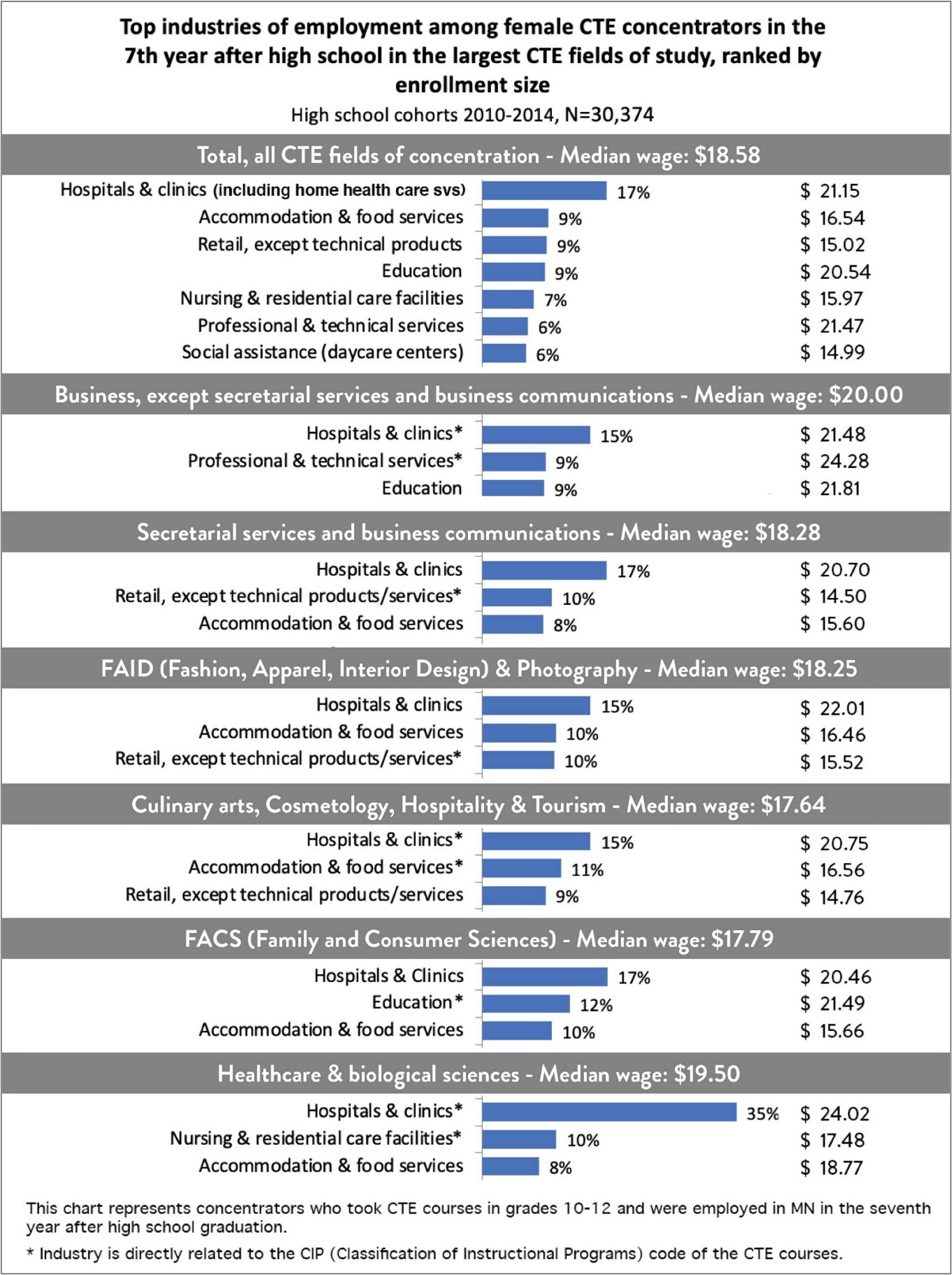
Despite the fact that only a minority of females concentrated in healthcare-related CTE courses (only 4,121 versus 18,950 in business, as shown in Table 3) the largest shares of students ended up working in Hospitals & clinics by very large margins, and 7% found jobs in Nursing & residential care facilities which are also in healthcare.
In fact, Hospitals & clinics are the top industry of employment regardless of what CTE pathway a student concentrated in during high school. This suggests that a large share of females who concentrated in something other than healthcare decided not to pursue the career paths inherent to their CTE concentration. In other words, the CTE field of concentration does not appear to have aided entry into the industries were females eventually become employed.
CTE might have indirectly aided entry into the healthcare industry through the teaching of human service-related content areas and soft skills, but postsecondary credentials (especially in healthcare) are what candidates for the industry need the most. This seems confirmed by the fact that 80% of female concentrators who ended up working in Hospitals & Clinics completed a postsecondary credential, and among them, 70% with a major in healthcare or biology. So, the industry distributions displayed in Figure 5- showcasing Hospitals & Clinics at the top- is driven by postsecondary major more than by high school CTE. With the exception of healthcare-related CTE programs, Culinary arts, and Business except secretarial services12, employment in healthcare does not appear directly connected to the other high school CTE pathways displayed in Figure 5.
The healthcare industry, especially Hospitals & Clinics, is attractive to job seekers because hiring is strong in a variety of occupations from low-skilled food preparation workers and home health aides to high-skilled healthcare professionals. Although we have no information on occupation, wages offer a clue to the most likely mix of occupations in which students were employed within an industry. In Figure 5, median wages earned in Hospitals & Clinics range from $20.46 among FACS concentrators to $24.02 among healthcare concentrators. The reason for this difference is that students with a background in healthcare-related CTE are more likely to have obtained a postsecondary credential needed to enter licensed occupations such as Registered Nursing, which are well paid and in demand. In contrast, students who concentrated in FACS and then entered the healthcare industry were less likely to be employed in a licensed healthcare occupation, judging from their lower wages.
The industry that provides the best fit for FACS concentrators is Education, where they earned higher wages ($21.49) most likely because they entered a teaching occupation. Unfortunately, only 12% found jobs in Education. Another 9% of FACS concentrators (not shown in Figure 5 for reasons of space) were employed in Social Assistance with median wages of $15.12. Employment in Social Assistance, which includes daycare centers and family services, is an example of strong alignment between the industry and the CTE pathway, and viable in terms of demand, but not in terms of wage.
Figure 5 also confirms our findings from Table 4 about programs in FAID (Fashion, Apparel, and Interior Design) and Photography. These courses are mostly geared towards industries like Manufacturing and Professional & Technical Services, yet only 10% of concentrators found jobs in these industries. A greater share (22%13) ended up working in healthcare, an unrelated industry. Either students chose these programs to pursue a hobby rather than a career goal, or these programs did not help them enter related industries due to low demand for design and photography skills. The latter would be a case of misalignment with labor market demand.
The concern, therefore, is that a female who concentrated in FACS or FAID and expected to earn a living wage in these fields without postsecondary credentials might need to change plans and pursue a different career path or further education after discovering that her original career aspirations were not financially viable; often this 'change in plans' appears to mean going into the healthcare industry. However, the potential penalties for this shift in goals are delayed career entry and/or unexpected investments in postsecondary training that may not result in credential completion. These shifts are detrimental to both the childcare industry and the healthcare industry by making both pipelines leaky and inefficient. Higher wages in the childcare industry would go a long way to attracting and retaining workers out of high school with these credentials. In a similar way, completing additional biology and chemistry courses, as well as a capstone work-based learning experience within a hospital setting could provide greater preparation for careers in healthcare. There are a number of work-based learning programs with close ties to the healthcare industry and a history of assisting students realize their future career goals.
Finally, Figure 5 confirms our findings from Table 4 about programs in Culinary arts/Cosmetology/Hospitality. These are the fields where CTE is doing its strongest work at boosting industry-readiness for females from disadvantaged backgrounds. These programs are effective at boosting employment in related industries14 but students need to be aware that currently the wages in some of these industries are low, especially in Accommodation & Food Services ($16.56).
Comparing these findings with the corresponding results for males (Figure 7 in the first report) it is clear that females did not find employment in industries directly related to their high school CTE subject area to the same degree as their male peers. This suggests that CTE participation was less effective at boosting industry-readiness among females.
These findings provoke the following question: given that most female CTE concentrators ended up working in healthcare, and healthcare-related CTE programs were extremely effective at boosting industry-readiness even among non-completers, why didn't more females concentrate in healthcare? The answer lies in the low availability of healthcare-related CTE electives from 9th grade. This problem, in turn, stems from the constraints on what can be taught in high school15. Licensing laws, intended to safeguard consumer safety when they receive medical or personal care services, impose burdens in the form of training paths that often cannot be started in high school. These burdens disproportionately impacted females16 but also impacted the industry's ability to benefit from CTE during the study period.
Insufficient course offerings leading to industry-certified credentials, combined with the lack of clear pathways from high school to postsecondary are likely the main reasons why females are less represented in CTE than males. Unless these shortcomings in CTE programming are addressed, female students are likely to look elsewhere in the high school curriculum as a better means of career preparation than CTE.
The implication of this analysis for gender wage gaps is that females have fewer opportunities than males to start preparing for their future industry of employment while in high school.
To get an idea of the size of the gender wage gap, Figure 6 plots annual earnings by education level in Greater Minnesota, where concentrating in CTE is more prevalent. Over seven years, the earnings of female college non-completers grew by 230% versus 319% among males. In Year 7, wages of male non-completers ($31,787) were closely trailing those of female completers ($34,420). This has equity implications, because females who invest in postsecondary education took seven years to barely surpass the earnings of males who did not make those investments.
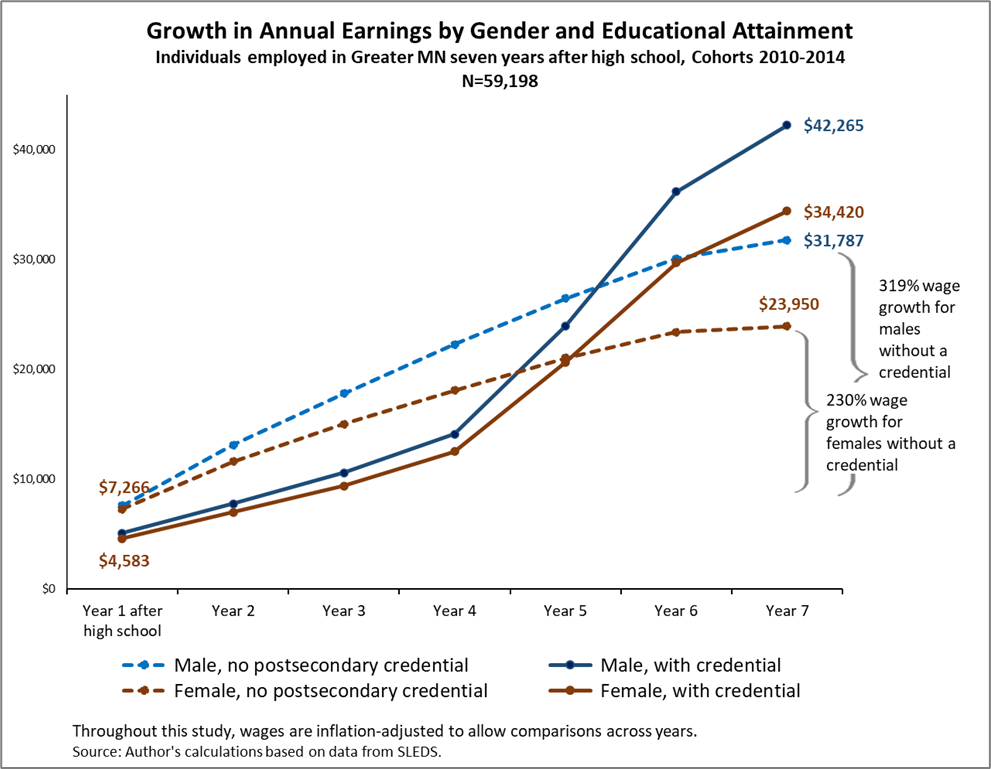
The success of male postsecondary non-completers in Greater Minnesota is partially creditable to high school CTE. More than half (57%) of male non-completers displayed in Figure 6 participated in CTE as concentrators. Thus, paradoxically, the success of certain CTE programs in boosting workforce readiness among male non-completers gave them an extra advantage over females.
As mentioned before, concentrating in CTE leads to a modest earnings premium among females after controlling for postsecondary education, region of employment, and a host of other variables17, suggesting that the benefits outweigh the shortcomings. However, CTE programming should aim to do more to mitigate the effect of structural factors18 that put females at a disadvantage in the entry level labor market.
This is among the first studies ever conducted for the purpose of analyzing labor market outcomes among Minnesota CTE participants and concentrators seven years after high school. The aim was to investigate whether CTE students benefit from participating in state-approved CTE programs. The article documents four main mechanisms of participation in CTE that have greater influence on students' labor market outcomes:
From this body of evidence we conclude that, during the study years, participation in high school CTE was more effective at putting male students on a career trajectory than female students. As a consequence of job segregation and low wages in female dominated industries, females have fewer direct paths from high school to financially viable careers. Female students more often have to postpone job skills training until postsecondary school, with the financial burden it entails19, while males have more opportunities to obtain job skills training prior to graduating high school. Traditional female talent pipelines (healthcare, education, social work) are heavily dependent on postsecondary credentials. Setting up viable pathways from high school to postsecondary is not a low-hanging fruit. It involves collaborating with teacher training programs and developing articulation agreements with community colleges and four-year institutions. Much work has been done to develop and grow these pathways, yet much more is needed.
Paradoxically, the effectiveness of CTE among males might have exacerbated gender wage gaps in Greater Minnesota by providing males greater access to employer-provided on-the-job training as an alternative to investments in postsecondary education. Employers in manufacturing and construction have poured resources into high school CTE programs that have benefitted primarily males, while females seeking workforce entry right after high school remain largely underserved.
What can CTE do to make the four mechanisms work better for female students and thus prevent gender wage gaps from emerging right after high school? Three sets of recommendations are outlined below:
Given the severe workforce shortages in female-dominated occupations (teaching, nursing, childcare, food preparation and social work) it is in the best interest of employers and postsecondary schools to work more closely with local K12 institutions around designing more rigorous, industry-oriented CTE programs in these fields.
By helping female students begin career preparation while in high school, CTE could play a key role in increasing female representation in living-wage jobs that do not require a four-year degree, and ultimately bridge the opportunity gap that separates them from their male peers.
1Removing these individuals from the analysis does not change the breakdowns presented in Figure 1 and 2. Individuals who received special ed services before grade 11 and then stopped receiving them were kept in our dataset and thus are included in the analysis.
2Earnings must be tracked for at least six years after graduation to allow college-bound students to finish a four-year degree. Six years is the bachelor's degree completion cutoff used by the U.S. Department of Labor. Therefore, six years after high school is the time when the earnings of college-bound-students begin to be comparable with the earnings of non-college bound students.
3Being non-proficient is highly correlated with eligibility for free/reduced price lunch and with needing English Language services. Needing English language services, in turn, characterizes recent immigrants from non-English speaking countries.
4CulinaryProstart is a two-year high school program sponsored by the National restaurant Association and leading to an industry-recognized credential.
5A supplementary analysis based on statistical modelling using the OLS method revealed that concentrators have significantly higher, though small in size, earnings outcomes than other students seven years after high school after controlling for a broad set of variables including gender, race, eligibility for special ed services at any time in K-12, eligibility for free/reduced price lunch, English language learner status, attendance in 8th grade, math and reading proficiency in 8th grade, type of high school attended, high school graduation cohort, location of the high school, location of employment, and participation in special programs in high school (Adult Basic Education, Concurrent Enrollment, PSEO, and Advanced Placement courses). CTE concentrators still earn more than others even after controlling for years of future postsecondary education, CTE field of concentration, and industry of employment.
6With the exception of a slight decline in the share of females concentrating in FACS (from 80% in 2010-2012 cohorts to 71% in the 2017 cohort) and a slight increase in females concentrating in healthcare, the gender composition of the CTE fields of study displayed in Figure 4 has not changed from the 2010 to the 2017 high school cohorts.
7According to the cost of living tool, a family-sustaining wage in Minnesota is $18.85. This benchmark is based on the fact that the most typical family structure in Minnesota is one fulltime worker, one part-time worker, and one child.
8See Table 3 in A. Leibert, Males in Career and Technical Education.
9Students without a four-year credential are precluded from obtaining a licensure and entering the teaching profession.
10According to the Minnesota Department of Education Academic Standards Course Framework in Fashion, Apparel, Textiles, and Design, these courses are aimed at preparing for work in the textiles and apparel industry, including knitting, cutting, sewing, pressing. According to the Employment Outlook tool, Apparel Manufacturing (NAICS code 315) is projected to shrink by 20% from 2018 to 2028. Textile Mills (NAICS 313) is projected to shrink by 15%. Textile Product Mills (NAICS 314) is projected to grow by 1.8% (below average), corresponding to only 54 jobs in ten years. According to the BLS Occupational Employment Statistics, in Minnesota there are about 170 Fashion designers, 1,690 Interior designers (of which 1,470 in the Twin Cities and very few on Greater Minnesota).
11The Perkins V Act, which became law in 2018, requires applicants to conduct a comprehensive local needs assessment to be updated every two years.
12These programs teach hands-on skills in accounting, finance, business law, and business administration, which are highly transferable to the Hospitals & Clinics industry especially when paired up with a postsecondary credential.
1315% in Hospitals & Clinics and 7% in Nursing & residential care facilities.
14Employment in Hospitals & Clinics appears well aligned with coursework in Culinary arts, Cosmetology and Hospitality because workers with hands-on skills in food preparation/serving, lodging, and personal care (skin care, cutting hair, etc.) are needed in hospitals, clinics, and home health care services. These jobs either do not require postsecondary training or require short training.
15During the study years, entry-level credentials in healthcare, such as a Certified Nursing Assistant, were only available to individuals beginning at age 16. These and other restrictions were removed in 2021 in an attempt to remedy severe workforce shortages.
17For a more complete list of variables used in the OLS regression model see footnote 5.
18Some of these structural factors are documented in this study. The industries that are hire the most in Greater Minnesota (Manufacturing, Mining, Construction, Utilities, Transportation, and Wholesale) are the most male-dominated in the state, with males representing from 70 to 85.8% of the workforce. Greater Minnesota offers very few functional career pathways in female-dominated careers for individuals without postsecondary credentials. Figure 3 and 4 show how white males in Greater Minnesota who enrolled in postsecondary school and dropped out still managed to find a job in high-paid industries while white females were primarily employed in Retail or Accommodation & Food service at very low wages. This is partially due to choice of major, but also to gender itself. It is also likely that some of these males chose not to invest in postsecondary credentials precisely because they were able to access well-paid jobs right out of high school.
19According to national statistics, it takes women an average of two years longer than males to pay off their student loans. Even in Minnesota female college students have higher student debt than their male peers (see page 12 of Status of Women & Girls in Minnesota).